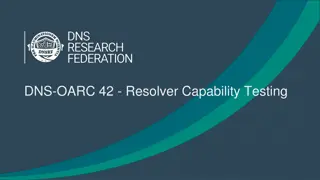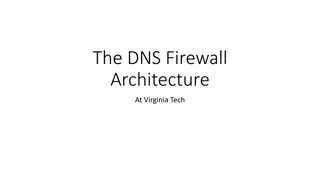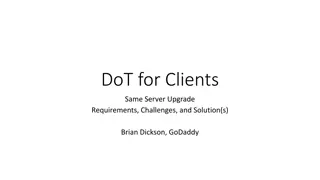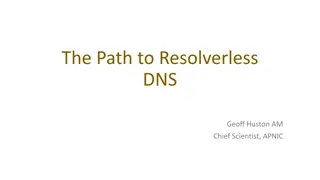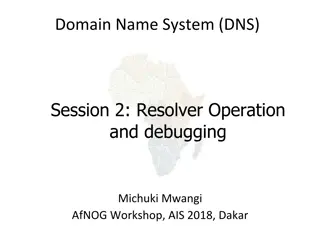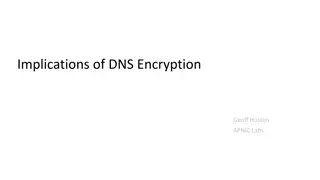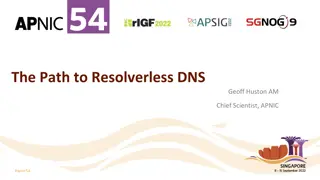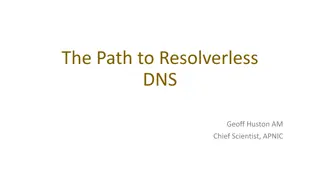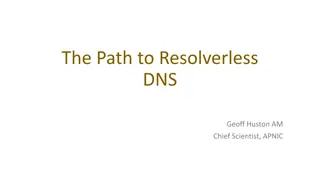
Resolvers We Use vs. DoH Debate: Insights from Geoff Huston at APNIC
Delve into the contentious DoH debate surrounding DNS over HTTPS, exploring perspectives on DNS privacy and centrality. Geoff Huston of APNIC sheds light on measuring internet behavior via users and resolvers, highlighting the complex landscape of DNS infrastructure.
Download Presentation

Please find below an Image/Link to download the presentation.
The content on the website is provided AS IS for your information and personal use only. It may not be sold, licensed, or shared on other websites without obtaining consent from the author. If you encounter any issues during the download, it is possible that the publisher has removed the file from their server.
You are allowed to download the files provided on this website for personal or commercial use, subject to the condition that they are used lawfully. All files are the property of their respective owners.
The content on the website is provided AS IS for your information and personal use only. It may not be sold, licensed, or shared on other websites without obtaining consent from the author.
E N D
Presentation Transcript
The Resolvers We Use Geoff Huston APNIC
The DoH Debate DNS over HTTPS (DoH) has excited a lot of reaction: Some see this as trying to stop the widespread abuse of users via existing DNS inspection and manipulation practices (the DNS Privacy argument) Some see this as browsers bypassing a diverse ISP DNS infrastructure and passing DNS traffic to a far smaller set of open resolver operators (the DNS Centrality argument)
DNS Centrality Will DoH make DNS Centrality worse ? Hard to say with knowing: How good/bad is DNS Centrality today? Hard to answer without data: Can we measure DNS Centrality?
Measuring the Internet via its Users At APNIC Labs we ve been using online ads to measure the user s view of the Internet for some years We ask users to fetch a unique URL This involves a DNS resolution and a HTTP GET to our servers So we collect sets of DNS queries and user data We need to match the endpoint against the recursive resolver that performs the DNS query to the auth server
Users and Resolvers These data sets also allow us to match the IP address of the resolver that queries the authoritative name server (the visible resolver ) to the IP address of the client plztform that retrieves the URL
Top 25 Resolvers By IP Address Rank Resolver Use % AS AS Name Rank Resolver Use % AS AS Name 1 125.5.210.212 2 196.188.52.8 3 202.56.215.67 4 2401:4900:50:9::5 5 129.205.112.254 6 101.95.144.211 7 2405:200:160c:1957:78::6 0.27% 8 49.45.29.22 9 2405:200:160c:1957:78::4 0.27% 10 49.45.29.20 11 49.45.29.21 12 2405:200:160c:1957:78::5 0.26% 13 221.228.15.194 14 101.95.144.210 15 219.128.128.102 16 2405:200:1613:1957:78::4 0.20% 17 49.44.189.220 18 2405:200:1613:1957:78::5 0.20% 19 49.44.189.221 20 49.44.189.222 21 2405:200:1613:1957:78::6 0.20% 22 49.45.28.53 23 2405:200:1609:1957:78::5 0.19% 24 2405:200:1609:1957:78::7 0.19% 25 49.45.28.55 0.57% 0.49% 0.34% 0.34% 0.28% 0.27% AS7629 AS24757 AS24560 AS9498 AS37148 AS4812 AS55836 AS55836 AS55836 AS55836 AS55836 AS55836 AS4134 AS4812 AS58543 AS55836 AS55836 AS55836 AS55836 AS55836 AS55836 AS55836 AS55836 AS55836 AS55836 EPLDT, PH EthioNet-AS, ET Bharti Airtel, IN Bharti Airtel, IN Globa Com, NG China Telecom, CN Reliance Jio, IN Reliance Jio, IN Reliance Jio, IN Reliance Jio, IN Reliance Jio, IN Reliance Jio, IN Chinanet Backbone, CN China Telecom, CN China Telecom, CN Reliance Jio, IN Reliance Jio, IN Reliance Jio, IN Reliance Jio, IN Reliance Jio, IN Reliance Jio, IN Reliance Jio, IN Reliance Jio, IN Reliance Jio, IN Reliance Jio, IN This list looks pretty strange! 0.27% A number of these resolvers share the same subnet are they different resolvers or part of a larger resolver farm ? 0.27% 0.27% 0.25% 0.25% 0.21% 0.20% 0.20% 0.20% 0.19% 0.19%
Top Resolvers by Origin AS Rank Resolver Use % Rank Resolver Use % 1 Google DNS Google DNS 2 AS55836 3 AS4134 4 AS4837 5 AS9498 6 AS9808 7 114dn 114dns 8 OpenDNS OpenDNS 9 AS58543 10 AS24560 11 dnspai dnspai 12 AS38266 13 OneDns OneDns 14 AS8151 15 AS45271 16 AS56040 17 AS7922 18 Cloudflare Cloudflare 19 Level3 Level3 20 AS23693 21 AS56046 22 AS9121 23 AS17974 24 AS7629 25 AS132199 Open Resolver / AS Open Resolver / AS GOOGLE, US Reliance Jio, IN ChinaNET Backbone, CN China Unicom, CN Bharti Airtel, IN China Mobile, CN ChinaNET Backbone, CN OpenDNS, US China Telecom, CN Bharti Airtel, IN China Telecom, CN Vodafone India, IN China Unicom Beijing Province Network, CN Uninet, MX Idea Cellular, IN China Mobile, CN Comcast, US Cloudflare, US Level 3, US Telekomunikasi Selular, ID China MobilE, CN TTNET, TR Telekomunikasi Indonesia, ID EPLDT, PH Globe Telecom, PH 9.39% 7.89% 5.22% 2.86% 2.17% 1.66% 1.55% 1.49% 1.47% 1.25% 1.19% 1.10% 1.01% 0.92% 0.88% 0.83% 0.79% 0.76% 0.76% 0.73% 0.71% 0.66% 0.65% 0.63% 0.58%
First Resolver or Full Resolver Set? End hosts are often configured with 2 or more recursive resolvers Is there much of a change in the use of recursive resolvers when we look at this full resolver set? Lets re-run this test with an authoritative name server that always returns the SERVFAIL response code
Top Resolvers by Origin AS Rank Resolver Use % Rank Resolver Use % 1 googlepdns 2 AS55836 3 AS4134 4 AS4837 5 114dns 6 AS9498 7 opendns 8 AS24560 9 AS9808 10 level3 11 AS58543 12 dnspai 13 cloudflare 14 onedns 15 AS38266 16 AS56046 17 AS8151 18 AS56040 19 AS45271 20 AS7922 21 AS23693 22 AS7629 23 AS9121 24 AS17974 25 AS132199 Open Resolver / AS Open Resolver / AS Google, US Reliance Jio Infocomm Limited, IN ChinaNET Backbone, CN China Unicom, CN ChinaNET, CN Bharti Airtel IN OpenDNS, US Bharti Airtel, IN China Mobile, CN Level 3, US China Telecom, CN China Telecom, CN Cloudflare, US China Unicom, CN Vodafone India, IN China Mobile, CN Uninet, MX China Mobile, CN Idea Cellular, N Comcast, US Telekomunikasi Selular, ID EPLDT, PH TTNET, TR Telekomunikasi Indonesia, ID Globe Telecom, PH 22.84% 7.92% 5.59% 3.14% 3.13% 2.90% 2.56% 2.54% 1.87% 1.54% 1.53% 1.37% 1.23% 1.20% 1.10% 1.05 % 1.00% 0.96% 0.91% 0.80% 0.73% 0.70% 0.68% 0.66% 0.58% Full Resolver Set
Resolver Distribution 90% of users 450 visible resolver sets handle the query load for 90% of all users Just 3 resolver farms are used by 30% of users!
Counting Resolver Use 55% of users use resolvers located in the same network 40% of users use resolvers located in the same country 23% of users use Google s public DNS service https://stats.labs.apnic.net/rvrs
Mapping Open Resolvers For each country can we show the distribution of the resolvers used by users located within that country?
Mapping Open Resolvers %Clients using ISP resolvers per Economy
Mapping Open Resolvers %Clients using Open Resolvers per Economy
Why is this happening? At lot of this story is Google s Public DNS, which now has a market share of more than 9% of the entire Internet s user population for first query, and included in 23% of all users full resolver sets In some cases individual users may want to circumvent content control via national DNS filtering measures In other cases ISPs redirecting queries towards Google, as its cheaper than running a local recursive DNS resolver service! Most users never twiddle the knobs so its ISP / application settings rather than user settings that lie behind this resolver distribution
Netherlands All Resolvers 66% of users use resolvers located in the same network 55% of users use resolvers located in the Netherlands 19% of users use Google
DNS Centrality? Today: Not really Google s service is used largely because ISPs (and some applications) direct queries to their service All other open resolvers have negligible market share from an Internet-wider perspective
Where is the DNS heading? Is the DNS under pressure to aggregate to ever larger resolvers and server farms? What is the economic model of name resolution in a highly aggregated environment? Will resolver operators rely on data mining of queries to generate revenue streams? Is it possible to reduce the information exposure while still using common resolver caches? What is the nature of the trade-off between resolution performance and information leakage in DNS resolution? Will application-specific name realms take over this space? Are we seeing the end of the current model of a single infrastructure-level DNS?



